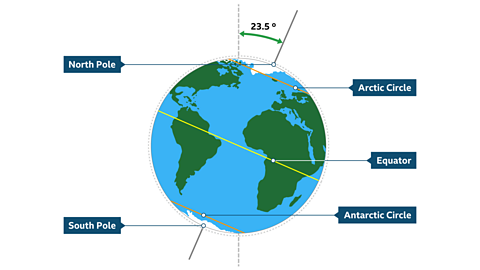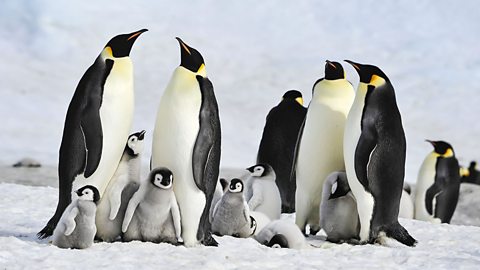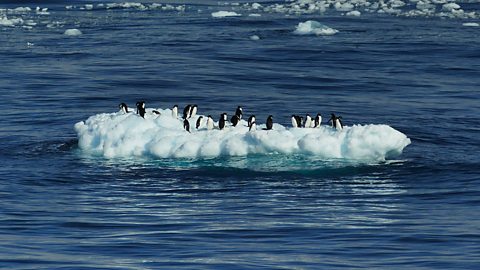What do you know?
Question
Where is Antarctica?
Antarctica lies at the South Pole.
Key points
- Antarctica is a frozen continent at the South Pole. The average temperature is around -30 Ā°c.
- Some species have adapted to survive the hostileA place that is uncomfortable or difficult to live in. conditions in Antarctica. These include lichen, mosses, penguins and whales.
- Nobody owns Antarctica.Ā It has no government or permanent population.Ā Antarctic TreatyAn agreement that protects the continent of Antarctica. is an agreement to help manage the continent.
Activity: Explore Antarctica
Weather and climate

Antarctica is a frozen continent at the South Pole. The average temperature is around -30 Ā°c, but mountainous areas inland are much colder, falling to temperatures of -60 Ā°c. The continent is a desertAn area that receives less than 250 mm of rainfall or snow a year. as snow rarely falls.
Antarctica experiences strong katabaticWinds that flow downwards from a higher area. winds, as cold air flows down from inland areas towards the coast. The coastline of Antarctica is one of the windiest places in the world.
Antarctica has distinct seasonA period of the year that has similar characteristics, such as temperature, light levels. Examples of seasons in the UK are summer and winter.. During the Antarctic winter, the continent has 24 hours of darkness. More ice forms and the continent doubles in size. In contrast, there are 24 hours of daylight in the Antarctic summer.

Look at this slideshow to see how the position of the Earth affects seasons in Antarctica.

Image caption, The Earthās axis is tilted at roughly 23.5 Ā°.
Image caption, During the UK summer, the Northern Hemisphere is pointing towards the sun. This gives the UK warmer temperatures and longer days.
Image caption, During the UK winter, the Southern Hemisphere is pointing towards the sun. This gives the UK cooler temperatures and shorter days.
Image caption, Antarctica lies at the South Pole. During the UK summer, Antarctica lies in total darkness. During the UK winter, the sun rises above the horizon in Antarctica. The continent has 24 hours of daylight and temperatures are slightly warmer.
1 of 4
Question
Why is Antarctica covered in ice?
Although it rarely snows in Antarctica, any snow that does fall is not able to melt and so compacts to form ice. The average temperature in Antarctica is around -30 Ā°c. This is too cold for ice to melt.
How have animals and plants adapted to Antarctica?

Some animal species have adaptedWhen a plant or animal has changed to suit its environment. to survive the hostileA place that is uncomfortable or difficult to live in. conditions in Antarctica. For example, penguins have flippers to help them to swim and feathers to trap warm air close to their bodies.
Plant species such as lichenA small, slow-growing organism that is often found on rocks and trees. and mossA small flowerless plant that grows in damp places. Mosses donāt have roots and so can grow in places where there is very little useable soil. grow, particularly around coastal regions.
The ocean contains a range of life, including phytoplanktonMicroscopic algae that live in the ocean., krillSmall shrimp-like creatures that live in the ocean. and whales.

Who owns Antarctica?
Nobody owns Antarctica. It has no government or permanent population. During the 20th century, North American and European explorers raced to become the first to explore Antarctica. In 1911, Norwegian explorer Roald Amundsen became the first to reach the South Pole. His team were closely followed by Robert Falcon Scott of the United Kingdom. The expeditionA journey to explore somewhere. were dangerous but deemed important as a show of strength and power over other nations.
Antarctica is a global commonAn area that lies outside the control of any nation, for example outer space and Antarctica., which means it is outside of the control of any one country. Many countries work together in Antarctica and so the continent needs careful management to ensure that it is not destroyed.
Question
What are the high seas?
The high seas are areas of open ocean that lie far away from any coastline. A country has control over the ocean that lies close to its coastline, but no country has control over the high seas. Both the high seas and Antarctica are global commons
Play the Planet Planners game! gamePlay the Planet Planners game!
Make decisions for the planet in this KS3 geography game.

More on Antarctica and polar regions
Find out more by working through a topic
- count2 of 2
